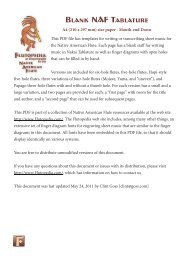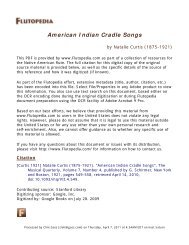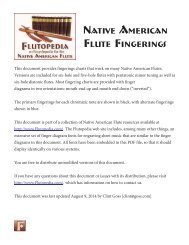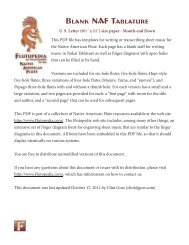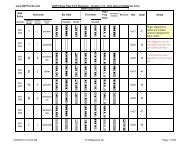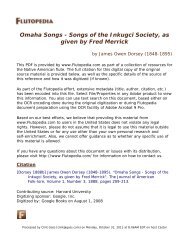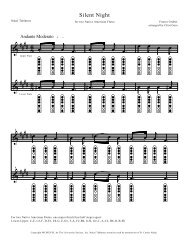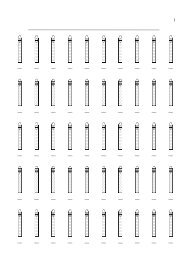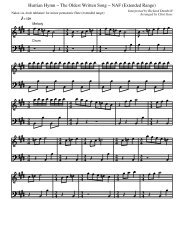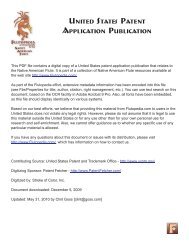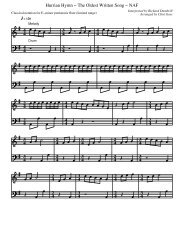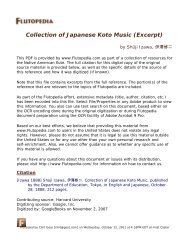Music of Acoma, Isleta, Cochiti, and Zuñi Pueblos - Flutopedia.com
Music of Acoma, Isleta, Cochiti, and Zuñi Pueblos - Flutopedia.com
Music of Acoma, Isleta, Cochiti, and Zuñi Pueblos - Flutopedia.com
You also want an ePaper? Increase the reach of your titles
YUMPU automatically turns print PDFs into web optimized ePapers that Google loves.
^<br />
62 BUREAU OP AMERICAN ETHNOLOGY [Bull. 165<br />
Translation<br />
Early this morning the <strong>com</strong>ing <strong>of</strong> the sun,<br />
For what purpose is it <strong>com</strong>ing?<br />
Perhaps for the cornmeal it is <strong>com</strong>ing.<br />
Yonder in the west at Shiawibat "<br />
All <strong>Isleta</strong> maidens, what do you think?<br />
What do you say? Shall we sit <strong>and</strong> sing?<br />
Early this morning the <strong>com</strong>ing <strong>of</strong> the sun,<br />
For what purpose is it <strong>com</strong>ing?<br />
Perhaps for the yellow dust from the corntassels [pollen] it is <strong>com</strong>ing.<br />
Yonder in the west at Shiawibat,<br />
People <strong>of</strong> Shiawibat, what do you think?<br />
What do you say? Shall we sit <strong>and</strong> sing?<br />
Early this morning the <strong>com</strong>ing <strong>of</strong> the sun,<br />
For what purpose is it <strong>com</strong>ing?<br />
Perhaps for sons <strong>and</strong> daughters <strong>of</strong> the people it is <strong>com</strong>ing.<br />
Yonder in the west,<br />
People, what do you think?<br />
What do you say? Shall we sit <strong>and</strong> sing?<br />
" The native name <strong>of</strong> <strong>Isleta</strong> Pueblo Is "Shlewhibak."<br />
Analysis.—The form <strong>of</strong> this melody is similar to other corn-grinding songs <strong>and</strong><br />
<strong>com</strong>prises an introduction <strong>and</strong> three rhythmic periods, designated as A, B, <strong>and</strong> C.<br />
In this song, period B begins with the same phrase as period A, but soon changes<br />
to a rhythm <strong>of</strong> it's own. The tones are chiefly those <strong>of</strong> the major triad E-flat-Gr-<br />
B-flat, but a minor third constitutes one-half <strong>of</strong> the progressions. With few<br />
exceptions this minor third is G-B-flat which forms the pivot <strong>of</strong> the melody,<br />
additional intervals being excursions above or below it. The keynote is in the<br />
lower octave <strong>and</strong> usually occurs on the unaccented portion <strong>of</strong> the measure,<br />
followed by a rest which seems to give prominence to the tone.<br />
No. 42.<br />
,<br />
J r 84<br />
• g' , • • •<br />
*>¥arrr:r i<br />
The sun <strong>and</strong> the yellow corn<br />
A<br />
.. • •<br />
(Catalog No. 1994)<br />
rrp7 iKrirPy-/ ^j—<br />
n\ r P ^ 7 1<br />
^^ ^^<br />
m<br />
r<br />
r tr^ s<br />
9 I<br />
^m<br />
JC<br />
^m<br />
-0-0-<br />
'i^ Q<br />
l<br />
'i llfyi^



